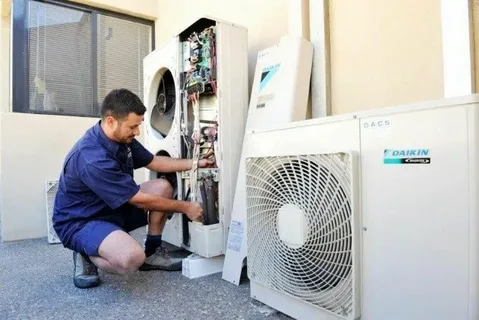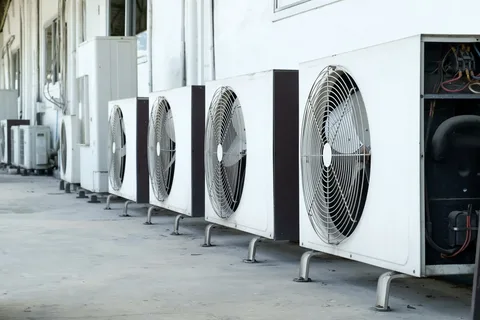Is the air quality inside your home making it difficult to breathe? Are you looking for ways to improve the air quality and make your home more comfortable? Whole house air exchanger is a great way to improve indoor air quality and create a healthier, more comfortable living environment. House air exchangers can provide ventilation that will help you and your family breathe easier by exchanging stale, contaminated air for fresh air. Learn more about the benefits of house air exchangers today!
Understanding Indoor Air Quality
Indoor air quality is a crucial aspect of our overall health and well-being, yet it is often overlooked. The air inside our homes can be up to five times more polluted than outside air, according to the Environmental Protection Agency. This is due to various factors, such as inadequate ventilation, allergens and pollutants, and the use of certain household products.
Poor indoor air quality can lead to various health issues, including respiratory problems, allergies, and asthma. It can also affect our sleep, mood, and cognitive function. Understanding the factors that contribute to indoor air pollution is the first step towards improving the air quality in your home.
Common sources of indoor air pollution include dust mites, pet dander, mold, volatile organic compounds (VOCs) from cleaning products and furniture, and even cooking fumes. Additionally, inadequate ventilation can lead to the buildup of these pollutants, exacerbating the problem.
Investing in a house air exchanger can effectively remove these pollutants and bring fresh, clean air into your home. House air exchangers exchange stale, contaminated air with fresh outdoor air, providing much-needed ventilation. This helps to dilute pollutants and ensure a healthier living environment.
How House Air Exchangers Work?
House air exchangers use ducts and fans to exchange stale, contaminated air from inside your home with fresh outdoor air. This process, known as ventilation, helps improve the air quality in your home by diluting pollutants and ensuring a constant supply of clean air.
The first step in the process is the intake of fresh outdoor air. This air is typically filtered to remove large particles or pollutants before entering your home. Once inside, the fresh air is distributed throughout your home via ducts and vents.
At the same time, the system simultaneously removes the stale indoor air from your home. This air is expelled through a separate set of ducts and vents, ensuring no mixing between the incoming and outgoing air streams.
Many house air exchangers use a heat recovery ventilation (HRV) system to maximise energy efficiency. This system transfers heat from the outgoing air to the incoming air, helping to maintain a consistent temperature inside your home. This means you can enjoy the benefits of fresh air without excessively heating or cooling your home.
Freshen Your Home with Heat Exchanger Air To Air
Are you tired of stale, stuffy air in your home? Are you constantly opening windows to let in some fresh air, only to let in allergens and pollutants as well? It’s time to freshen your home with a heat exchanger air to air system.
An exchanger air to air system is a type of house air exchanger that uses a heat recovery ventilation (HRV) system to exchange stale indoor air with fresh outdoor air. This process helps improve the air quality in your home and helps maintain a comfortable temperature.
With a heat exchanger system, you can enjoy the benefits of fresh, clean air without sacrificing energy efficiency. The system transfers heat from the outgoing air to the incoming air, helping to maintain a consistent temperature inside your home. This means you can enjoy the benefits of fresh air without wasting energy on excessive heating or cooling.
In addition to improving air quality and energy efficiency, a heat exchanger system can also help reduce humidity levels in your home. Removing excess moisture can prevent mould and mildew growth, which can lead to respiratory issues and other health problems.
The Benefits of Small HRV Units
Small HRV (heat recovery ventilation) units can be a game-changer when it comes to improving the air quality in your home. These compact and efficient devices offer a range of benefits that can greatly enhance your living environment.
One of the key advantages of small HRV units is their size. Unlike larger air exchangers, which can take up a significant amount of space, HRV units are designed to fit seamlessly into any home. They can be easily installed in tight spaces or incorporated into existing HVAC systems, making them a flexible and convenient choice.
Despite their size, HRV units are highly effective at improving indoor air quality. They work by continuously exchanging stale indoor air with fresh outdoor air, reducing pollutants and ensuring a constant supply of clean air. This can help alleviate respiratory issues, reduce allergens, and create a healthier living environment for you and your family.
In addition to their air purification benefits, HRV units also offer energy efficiency advantages. By recovering heat from the outgoing air and transferring it to the incoming air, these units help maintain a consistent temperature inside your home. This can result in lower energy bills and a reduced carbon footprint.
Choosing the Right Heat Recuperator
Choosing the right heat recuperator for your house air exchanger is an important decision that can greatly impact the performance and efficiency of your system. With so many available options, it can be overwhelming to determine which recuperator is best suited for your needs.
First, consider the size of your home and the airflow requirements. A recuperator that is too small may not effectively exchange air, while one that is too large may lead to energy waste. Look for a heat recuperator that is properly sized to match your home’s ventilation needs.
Next, consider the energy efficiency of the recuperator. Look for a model with high heat recovery efficiency (HRE), which indicates how effectively the unit recovers heat from the outgoing air. A higher HRE means more heat is transferred from the outgoing air to the incoming air, resulting in greater energy savings.
Additionally, consider the noise level of the recuperator. Look for a model that operates quietly, especially if you plan on installing the unit in a living area or bedroom. A noisy recuperator can be disruptive and may impact your overall comfort.
Lastly, consider the maintenance requirements of the recuperator. Look for a model that is easy to clean and maintain, as regular maintenance is crucial for optimal performance. Consider factors such as filter replacement frequency and ease of access to internal components.
By carefully considering these factors and choosing the right heat recuperator for your house air exchanger, you can ensure that your system operates efficiently and effectively, providing you and your family with clean and fresh air.
Maintaining Your House Air Exchanger
Regular maintenance is key to ensure that your house air exchanger continues to operate effectively and efficiently. Here are some important maintenance tasks to keep in mind:
- Clean or replace filters: The filters in your house air exchanger are designed to trap dust, allergens, and other particles from the incoming air. Over time, these filters can become clogged, reducing the system’s efficiency. It’s important to regularly clean or replace the filters according to the manufacturer’s instructions.
- Check and clean ventilation ducts: Over time, dirt, dust, and debris can accumulate in the ventilation ducts of your house air exchanger. This can restrict airflow and hinder the system’s performance. Regularly inspect the ducts and clean them if necessary to ensure optimal ventilation.
- Inspect the heat recuperator: The heat recuperator is vital to your house air exchanger. It’s important to regularly inspect it for any signs of damage or wear and tear. Additionally, clean the heat recuperator periodically to remove any buildup that may hinder its efficiency.
- Schedule professional maintenance: While homeowners can do regular cleaning and maintenance tasks, it’s also a good idea to schedule professional maintenance for your house air exchanger. A technician can inspect the system thoroughly, identify potential issues, and perform necessary repairs or maintenance tasks.
FAQs
1. How often should I replace the filters in whole house air exchanger?
Filters are crucial in trapping dust, allergens, and other particles from the incoming air. To ensure optimal performance, cleaning or replacing the filters regularly is important. The frequency will depend on factors such as the quality of your indoor and outdoor air and the manufacturer’s recommendations. We recommend checking the filters every few months and replacing them when they appear dirty or clogged.
2. Will a house air exchanger increase my energy bill?
Not at all! House air exchangers are designed with energy efficiency in mind. By using a heat recovery ventilation (HRV) system, these devices transfer heat from the outgoing air to the incoming air, helping to maintain a consistent temperature in your home. This means you can enjoy the benefits of fresh air without excessive heating or cooling, resulting in potential energy savings.
3. Can I install a house air exchanger myself?
While some DIY enthusiasts may be able to handle the installation, hiring a professional for the job is generally recommended. House air exchangers involve complex ductwork and electrical connections, and improper installation can lead to issues down the line. A professional technician will have the knowledge and experience to ensure a proper and safe installation, giving you peace of mind.
Conclusion
In summary, house air exchangers are essential for improving indoor air quality and creating a healthier and more comfortable living environment. These systems help dilute pollutants and ensure a constant clean air supply by exchanging stale, contaminated air for fresh outdoor air. This is especially important considering indoor air can be up to five times more polluted than outdoor air. Investing in a house air exchanger, such as a heat exchanger system or a small HRV unit, offers a range of benefits. Not only do these systems improve air quality, but they also help maintain a comfortable temperature and reduce humidity levels in your home. Their compact size and energy efficiency make them a practical choice for any household.



